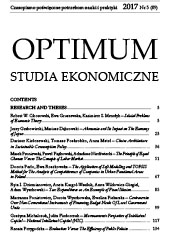Significance of Skandia Achievements in the Development of Approaches to Conceptualization and Assessment Models of National Intellectual Capital
Significance of Skandia Achievements in the Development of Approaches to Conceptualization and Assessment Models of National Intellectual Capital
Author(s): Julita Fiedorczuk, Grażyna MichalczukSubject(s): National Economy, Business Economy / Management
Published by: Wydawnictwo Uniwersytetu w Białymstoku
Keywords: national intellectual capital (NIC); Skandia Navigator; Skandia Value Scheme; conceptualization of NIC; assessment NIC models
Summary/Abstract: A noteworthy group among the national intellectual capital conceptual approaches, allowing to an assessment of the NIC level, are methods based on a model developed by L. Edvinsson within Skandia company. The model is called “Skandia Navigator” and is the one of world's first proposal of the comprehensive measuring tool to enable for an evaluation and management of the intellectual capital. The aim of the article is presentation of the significance of Skandia’s and L. Edvinsson's achievements in development of the national intellectual capital concept. In this research paper selected conceptual models NIC are analysed, which to some extent relied on Skandia’s model. The analysis was conducted paying special attention to the methodological apparatus structure and operationalization. The article is an effect of analysis main foreign literature and also aims at filling of the gap, which exists in publications about the NIC concept. As a result of the considerations set out in this article, the following conclusions can be drawn. Skandia Navigator became an universal construction, irrespective of the size and type of the object of analysis. Edvinsson’s model is constantly used as the foundation of assessment instrument in significant amount of scientific studies and reports for intellectual capital researches at the macroeconomic level. Original structure and assumptions of the method are slightly modified, but the changes depth never transform strongly Skandia prototype. This group of methods are easy to adapt and modify, what allow to adjust of the conceptualzation and methodology to the author's intentions and specific object of analysis. On the other hand, the ease of adaptation to identified conditions and applications may disclose the imperfections of the Skandia’s methods. Analyzed conceptual models consists of four components in this research paper. In each of them appeared human capital. The development capital was the second, next to market and process capital, most common distincted element in NIC models. L. Edvinson’s solutions (Skandia Navigator and Skandia Value Sheme) have been the pillars of many attempts of NIC assessment.
Journal: Optimum. Economic Studies
- Issue Year: 83/2016
- Issue No: 5
- Page Range: 17-30
- Page Count: 14
- Language: English

